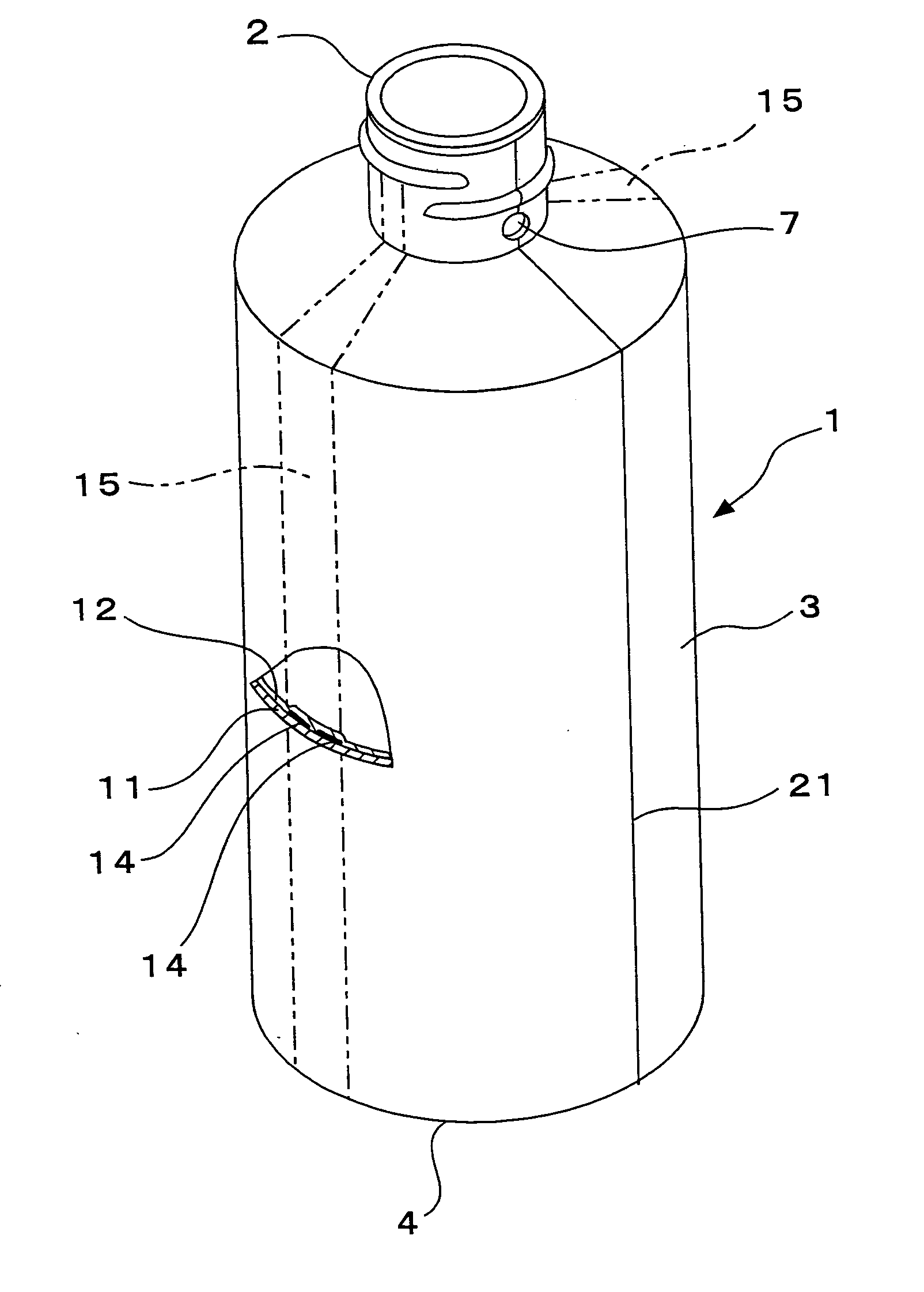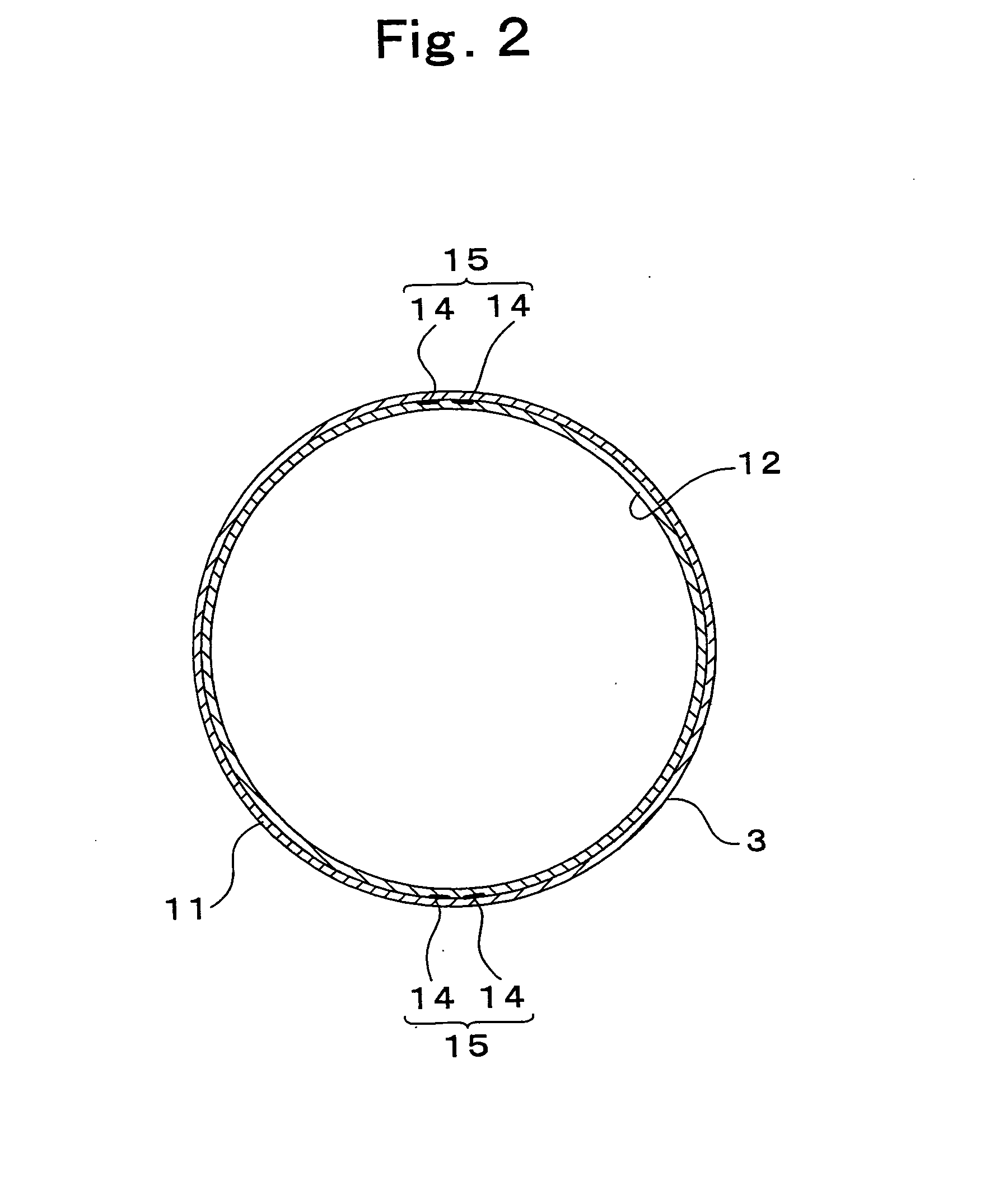Blow-molded container
a container and blow molding technology, applied in the field of blow molding containers, can solve the problems of cracking of the bottom seal, easy cracking of the outer layer at the bottom, and often found bottom cracking problems
- Summary
- Abstract
- Description
- Claims
- Application Information
AI Technical Summary
Problems solved by technology
Method used
Image
Examples
first embodiment
[0100] FIGS. 1-5 show the basic configuration of a blow-molded container in the first embodiment according to this invention. The container 1 is the blow-molded container comprising an outer layer 11 of a synthetic resin, such as polyethylene and polypropylene, which forms an outer shell having a necessary ability to maintain the shape of its own; an inner layer 12, which is molded into a flexibly deformable bag and is made of such a resin as nylon, ethylene-vinyl-alcohol copolymer, and polyethylene terephthalate, having no compatibility with the material of the outer layer 11; and the adhered zones 14 of the vertical strip type, which are disposed over the entire height of the container 1 and are made of an adhesive resin material that has full adhesiveness with both of the outer layer 11 and the inner layer 12. And a pair of restricted zones 15, each comprising a pair of or single adhered zones 14, is formed in the front and the rear of the container 1.
[0101] This container 1 has ...
second embodiment
[0120] When the container 1 in the second embodiment is blow-molded, the parison is set in the split blow mold at such a posture that two pairs of adhered zones 14 are put in the mold clamping direction taken from the central axis of the parison. As shown in FIG. 11, the adhered zones 14 reach the bottom seal 22 located on the parting line 21 of the bottom 4.
[0121] Two each of adhered zones 14, i.e., 14a1 and 14a2, or 14b1 and 14b2, are separated by the parting line 21 and are located opposite to each other. Thus, as shown in FIGS. 11 and 12, the lower ends of one pair of adhered zones 14 take the end-to-end positions facing those of the other pair of opposite adhered zones 14 in the central part of the pinched bottom seal 22 (hereinafter the portion in the end-to-end facing relationship between two adhered zones is referred to as the "end-to-end facing portion 24").
[0122] Therefore, as shown in FIGS. 13 and 14, the adhered zones 14 strongly adhere and fix the outer layers 11 on bot...
third embodiment
[0127] FIGS. 16, 18, 20, and 21 show the container 1 in this invention. The container 1 comprises an outer layer 11 of a low-density polyethylene resin, an inner layer 12 of a nylon resin that has no compatibility with the low-density polyethylene resin, and adhered zones 14 made of an adhesive resin that is fully adhesive with both of the low-density polyethylene and the nylon.
[0128] The bottle-like container 1 comprises the bottom 4, the body 3 having a circular cross-section, and the cylindrical neck 2 disposed on the upper end of the body 3 via shoulder and having screw thread notched around the outer surface of this neck 2.
[0129] The container 1 has a height of 160 mm. The body 3 has a circular cross-section and the diameter (bore diameter) of 60 mm.
[0130] The outer layer 11 and the inner layer 12, which make up the container 1, are laminated peelably except for the portions adhered and fixed by the adhered zones 14. The outer layer 11 forms the outer container 5 having a suffi...
PUM
 Login to View More
Login to View More Abstract
Description
Claims
Application Information
 Login to View More
Login to View More - R&D
- Intellectual Property
- Life Sciences
- Materials
- Tech Scout
- Unparalleled Data Quality
- Higher Quality Content
- 60% Fewer Hallucinations
Browse by: Latest US Patents, China's latest patents, Technical Efficacy Thesaurus, Application Domain, Technology Topic, Popular Technical Reports.
© 2025 PatSnap. All rights reserved.Legal|Privacy policy|Modern Slavery Act Transparency Statement|Sitemap|About US| Contact US: help@patsnap.com



